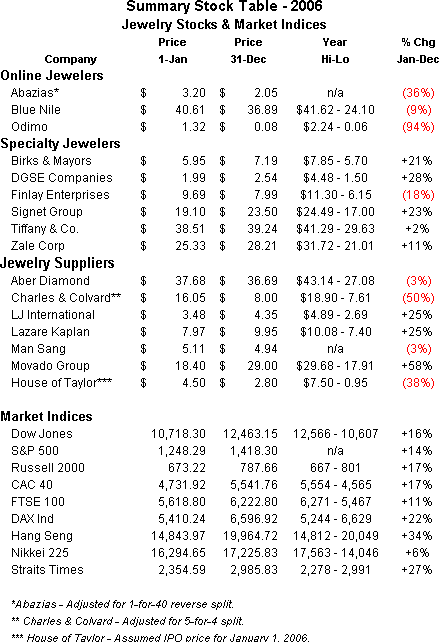IDEX Online Research: U.S. Jewelry Stocks Under-Perform in 2006
January 04, 07
Investors who put their money into U.S. jewelry stocks in 2006 were disappointed. While investments in three of the four model portfolios which IDEX Online tracks yielded gains for the year, jewelry stock investors would have been better off owning index portfolios consisting of the broad market indices – the Dow Jones and the S&P 500 – than owning jewelry stocks.
The stocks of online jewelers – Blue Nile, Odimo, and Abazias – dragged down the IDEX Jewelry Stock Index dramatically with a dismal 46 percent aggregate decline for the year. Increases among the other two segments – traditional specialty jewelers and jewelry suppliers – were not enough to offset weakness in the internet jewelry stocks. As a result, the composite model portfolio of “All Jewelry Stocks” was down for the year.
The graph below summarizes the annual investment performance of the four IDEX Stock Portfolios versus the broad-market S&P 500 Index. These portfolios assume that investors used the principle of diversification; that is, they invested an equal amount of money in each stock, without regard to the stock price, the fundamentals, or any other characteristic of the individual stocks in each portfolio.
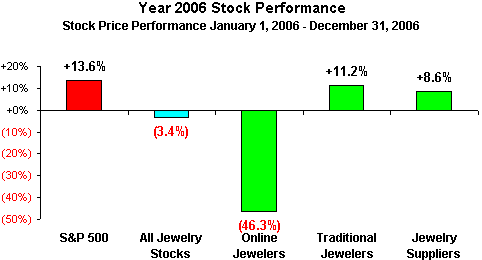
Source: Market reports
Fourth Quarter Performance Was the Driver of Annual Stock Gains
The fourth quarter was by far the best quarter for jewelry stocks, but even then, they under-performed the broad market indices. Similar to the third quarter, a strong stock market in the U.S. helped lift the prices of all jewelry stocks. Despite disappointing sales and earnings trends as well as uncertainty about the all-important holiday selling season, jewelry stocks posted an overall gain in the fourth quarter. Most of the jewelry stocks posted more than half of their annual gain in the fourth quarter.
The graph below summarizes the fourth quarter investment performance of the four IDEX Online Stock Portfolios versus the broad-market S&P 500. These portfolios assume that investors used the principle of diversification; that is, they invested an equal amount of money in each stock, without regard to the stock price, the fundamentals, or any other characteristic of the individual stocks in the portfolio.
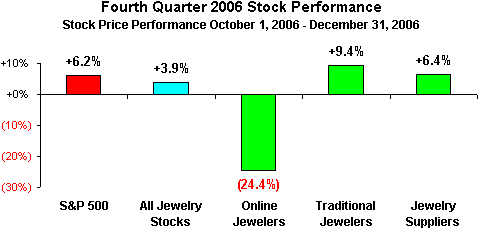
Source: Market reports
Fourth Quarter Investor Sentiment Shows Confidence
Earlier in 2006, it appeared that the world might be in trouble. Unsettled geopolitical conditions, a slowing economy, and general uncertainty restrained stock market gains. However, in the third quarter, investor sentiment turned positive. The same factors which created an inflection point in stock market performance in the third quarter had the same impact in the fourth quarter, including the following:
- Short term uncertainties resolved – Earlier in the year, investor uncertainties – Wall Street calls these uncertainties a “wall of worry” – were at very high levels. Those uncertainties included the following:
- Energy prices – Oil and gas prices rose to a pinnacle in July, and then began to retreat.
- Geopolitical stresses – Israel and Lebanon tangled in the Middle East, but achieved a cease-fire. Iran and North Korea engaged in saber-rattling.
- Economic growth slowing – Investors saw the prospects of a slowing global economy, but could not quantify it. Now, most forecasters call for a slowdown in 2007, with a recovery in 2008.
- Hard vs. soft landing – Most investors now believe that the global economy – especially the U.S. economy – will achieve a soft landing.
- Interest rates – It appears that interest rates are at or near their peak in most of the world’s major economies. As interest rates move lower over the next twelve months, economic growth will be stimulated.
- The environment – The 2006 hurricane and typhoon season was much more mild than many had predicted. As a result, there are far fewer business and personal dislocations and disruptions than Wall Street had anticipated. Gulf Coast energy producers were able to continue production of petroleum products at a normal rate.
-
- Long term outlook more positive – Many of the short term uncertainties that turned positive will also have a favorable impact on the longer term global outlook. Factors fueling a more positive long term outlook include the following:
- Profit recovery prospects – Investors can now see past the short term negative factors, and they believe that the longer term future looks brighter for corporate financials.
- Geopolitical stresses abating – Despite continuing challenges related to Iran, Iraq, and other geopolitical hotspots, it appears that each of these situations is in a “holding” pattern, awaiting diplomatic resolution.
- Oil prices moderating – Politics and demand have driven down oil prices in the past few months. Short of a one-time cataclysmic event, it is unlikely that oil prices will turn sharply higher near term.
- China – The government has begun to let the Chinese currency – the yuan – drift; further, top officials say they are trying to rein in potentially run-away economic growth in that country.
-
Online Jewelers’ Stocks Down
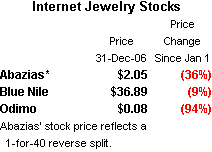 |
The shares of the “stellar” performer among the online jewelers – Blue Nile – posted a 9 percent price decline in 2006, dropping from nearly $41 per share at the beginning of the year to $37 at year’s end. Roller-coaster sales gains, declining margins, and the lack of an articulated detailed strategy had a negative impact on investor sentiment toward NILE shares. It appears that the company is back on track to post consistent results, but the market is taking a “wait-and-see” attitude.
Abazias implemented a one-for-forty reverse stock split in September 2006 in an effort to get its stock price out of the “penny-stock” arena. That move really didn’t help much, and ABZS shares continued their slow decline through the end of the year. Even the announcement that the company had raised additional capital – a mere drop in the bucket versus the amount really needed to get this company going – didn’t sooth investor concerns.
Odimo says it is a shell company. The shell is so thin and transparent that it doesn’t even cast a shadow in investor-land. What is it selling? Not much. It apparently has sold off its operating divisions – diamonds, luxury goods, etc. – and is left with no real assets, either tangible (cash, for example) or intangible (brands and dot.com names, for example). In February 2005, ODMO shares came public at $9 per share; they never rose above that level (except perhaps for a momentary trading spike), and they recently settled at $0.08 per share.
Jewelry Retailers’ Stocks Up
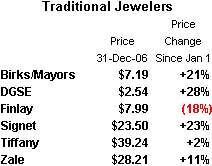 |
After a miserable 2005 and an uncertain early 2006, Zale’s shares climbed by 10 percent for the year. Most of this gain came earlier in the year; the shares were up just under 2 percent in the fourth quarter as investors began to question whether the company’s new management team could deliver results that would catch the attention of Wall Street. Sales increases have been very modest recently, and this has unnerved some investors in ZLC shares.
Signet Group, which operates as Sterling Jewelers (Kay, Jared, and regional brands) in the U.S., posted a solid 23 percent gain for the year. SIG shares drifted early in the year, but were up 13 percent in the fourth quarter. The only question on investors’ minds: can this company continue to deliver above-average revenue and profit gains?
Birks & Mayors continues its turnaround, and as a result, BMG shares were up 21 percent for the year. However, they drifted slightly lower in the fourth quarter; the reason is unclear.
Investors continue to be fascinated with Finlay Enterprises: the stock seems to move up and down without good reason. Company chairman Art Reiner has his work cut out for the Finlay team: transforming this company from exclusively operating leased jewelry departments in department stores into a company which is comfortable operating traditional specialty jewelers as well as maintaining a presence in the leased department business. It will be a challenge, but recent results are encouraging.
Jewelry Supplier Stocks Post Solid Fourth Quarter
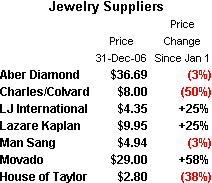 |
Movado was the stellar performer among the jewelry suppliers in 2006; its shares were up nearly 58 percent. The Movado team has assembled a stable of watch brands that have the potential to deliver consistent gains over the long term, and Wall Street is rewarding this sound strategy.
The biggest drag on the IDEX Online portfolio was the performance of Charles and Colvard; its shares plunged by about 50 percent for the year (adjusted for a 5-for-4 stock split in January 2006). Starry-eyed investors apparently thought that CTHR’s dramatic sales gains in 2004 and early 2005 – which represented initial sell-in of inventory to major chain customers – could be repeated quarter after quarter. When it became clear that sales gains were moderating, investors abandoned this stock. Company chairman Bob Thomas and his team have put this company on track for solid long term growth; short-sighted investors apparently don’t have the foresight to recognize the potential of moissanite jewelry.
LJ International is finally getting some recognition on Wall Street. With its stores in mainland China, it is one way to invest in China via a company which is supposed to report its results in accordance with U.S. GAAP and in accordance with standards for a NASDAQ listing. LJ’s Hong Kong-based accountants are unknown in the U.S., so it is difficult to confirm the integrity of its financials. However, JADE reports using Form 20-F to the Securities & Exchange Commission, which gives its results some credibility.
Luxury Stocks Outperform Market & Jewelry Segment
As a comparison to the jewelry stock portfolio, IDEX maintains an index of ten global luxury stocks, including Burberry, Coach, LVMH, and others. For the full year ended December 31, 2006, this group posted a very strong performance – up 23 percent. Virtually all of this performance came in the second half of the year.
The graph below summarizes the performance of a portfolio of luxury retail stocks versus jewelry stocks.
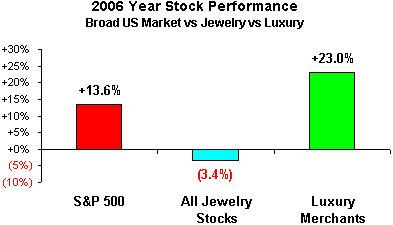
Source: Market reports
About the IDEX Online Jewelry Stock Portfolio
The IDEX Online Jewelry Stock Portfolio consists of publicly held companies which are tradable on U.S. exchanges. Stocks which sell below $1 are not included. If a stock falls below $1 and remains there, it will be dropped from the portfolio. Likewise, if a “penny stock” rises above $1 and remains there, it will be added to the portfolio. Results for the portfolio are based on buying an equal dollar amount of each stock, much like a typical stockbroker constructs a “balanced, diversified” portfolio. At the end of the quarter, the results are calculated on an equal-weighted basis. We note, however, that neither of the broad market indices – the Dow Jones and the S&P 500 – are calculated using this method. The Dow Jones is price-weighted, and the S&P 500 is market capitalization-weighted. Both of these methods would require us to buy and sell shares – sometimes fractional shares – on a daily basis to stay in balance. In short, these indices are not strictly comparable to our portfolio, but for our purposes, they are reasonable benchmarks.
The following table summarizes the IDEX Stock Portfolio stocks and their performance for 2006.
|
|
